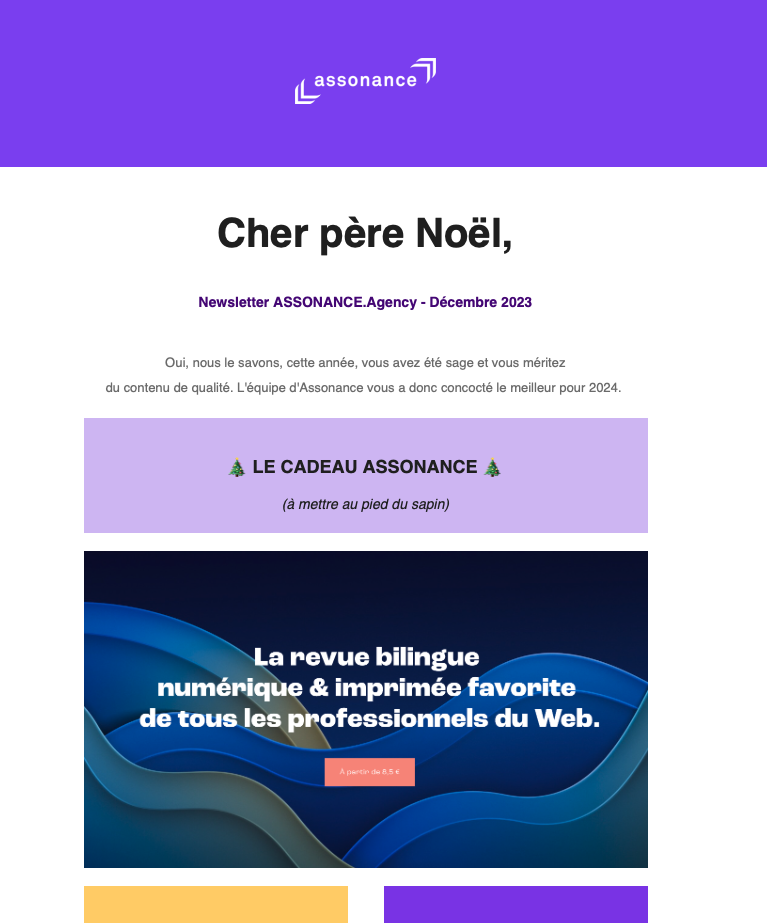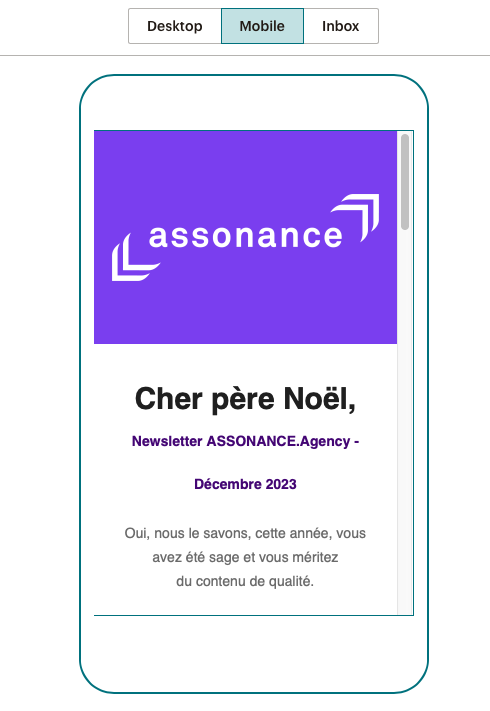Newsletter : 5 conseils pour créer un contenu efficace
Vous débutez dans l’exercice de la newsletter ? De nombreuses questions se posent lorsque l’on crée un premier template. Quel format doit respecter une newsletter, quelle quantité de texte écrire ou encore, à quelle fréquence l’envoyer ? Comment s’assurer que Jeanne, pendant sa pause du midi, ouvrira bien sa boîte mail pour lire les dernières actualités que vous avez à lui offrir ?
Si, comme toute stratégie marketing, l’efficacité des emailings ne relève pas d’une science exacte, celle-ci peut être optimisée et répondre aux besoins précis d’une audience bien déterminée. Quelques bonnes pratiques peuvent être utiles pour vous aider à construire une stratégie d’envoi d’emails efficaces. Parce que nos clients le valent bien.
Conseil n°1 : Connaître l’audience de votre newsletter et lui proposer un contenu adapté
Cela peut sembler être une évidence, mais le point de départ du travail de la création d’une newsletter réside dans le fait de capter l’attention d’une certaine audience : la vôtre.
Que vous ayez récupéré vos contacts sur un formulaire papier, via une pop-up en ligne sur votre site internet ou à travers la vente de produits et de services, sachez que votre base de données est très importante.
Certains membres de cette base de données sont très fidèles, d’autres le sont un peu moins. Il n’empêche qu’ils ont tous accepté à un instant T de recevoir des informations supplémentaires de votre part, en plus de votre communication habituelle (site web, campagnes de communication et réseaux sociaux).
La première des choses à faire avant de vous lancer dans la création d’un template de newsletter est de savoir à qui vous communiquez vos newsletters. Cela déterminera tout le reste !
💡 Attention à ne pas flouer les règles RGPD qui régissent les données de votre audience. Certaines règles sont à respecter à la lettre comme le fait de ne pas ajouter un contact à votre base de données sans son accord préalable. L’intégration d’un formulaire de désinscription est également nécessaire dans toutes les newsletters.
Savoir qui se cache derrière les contacts abonnés à votre newsletter
Selon l’origine de recrutement de vos contacts, vous pouvez déduire l’intérêt que ces derniers portent pour votre marque. Est-ce un abonnement qui fait suite à du sponsoring lancé sur vos réseaux sociaux ? À une promotion sur votre page d’accueil ? À un événement où vous avez rencontré des prospects ?
Pour faire le tri dans votre base de données, n’hésitez pas à créer des listes par type de clients ciblés. Ainsi, vous adaptez chaque campagne envoyée à une cible bien spécifique.
Sur Mailchimp, il est aussi possible de créer différents segments de contacts pour diviser votre audience en plusieurs catégories dont vous choisissez les critères. Cela peut être les suivants :
Les coordonnées : nom, prénom, adresse mail ;
Les données personnelles du contact comme l’âge ou la provenance géographique (à condition que la personne ait autorisé l’ajout de ces informations lorsque celle-ci avait rempli son formulaire d’inscription) ;
L’activité et la connexion du contact (pour sélectionner les contacts qui ont ouvert une ou plusieurs de vos précédentes newsletters par exemple).
Créez une campagne ciblée pour votre audience
Une fois que vous aurez importé et trié vos contacts, vous pouvez vous projeter sur un modèle de newsletter adapté à vos listes. Vous pouvez créer un template de newsletter par liste de diffusion pour vous permettre d’éditer plus facilement vos futures campagnes.
Les données statistiques d’envoi vous permettent, au gré des mailings, de savoir si votre base de données est active et si elle adhère davantage à un certain type de contenu.
Conseil n°2 : Aller droit au but.
Keep it short and simple ! Écrire un texte court mais efficace est un objectif que vous respectez dans l’écriture de vos rédactions au quotidien ? Cette règle s’applique aussi pour les newsletters. Chaque phrase doit contenir une information principale, et pas cinq.
La lecture doit être fluide et attrayante. Rappelez-vous que vous n’êtes pas l’unique expéditeur de newsletters, et que votre cible est noyée sous la réception de différentes sollicitations par mail. Pour s’assurer que votre contact consulte votre mail, il faut qu’il comprenne tout de suite l’objectif de son contenu. Passer par quatre chemins ou écrire de longs blocs de texte sans structure, c’est se mettre des bâtons dans les roues. Pensez plutôt à hiérarchiser vos informations en plaçant des titres en gras, des sous-titres et de courts paragraphes.
L’idée n’est pas de caser tout un article de blog dans une newsletter. Le mailing est un complément et une passerelle qui vise à inciter votre lecteur à aller visiter votre blog.
✅ RECOMMANDÉ : ajouter un bouton “Lire la suite”
Conseil n°3 : Structurer un design épuré et ergonomique.
Veillez tout d’abord à avoir une structure équilibrée qui soit adaptée à tous supports (mobile, écrans PC et tablette) en sachant que plus de la moitié des e-mails sont aujourd’hui lus sur mobile.
Profitez de votre template pour apporter du dynamisme à votre contenu. Ajoutez des images qui attirent l'œil et pourquoi pas des gifs (attention tout de même à garder un équilibre bien dosé pour ne pas que votre mail arrive directement dans les spams).
✅ RECOMMANDÉ : créer des sections dédiées
à la vidéo en intégrant un player vidéo ou un GIF
💡 Avant d’envoyer votre mailing, vous pouvez prévisualiser le format d’apparition de votre newsletter (en version mobile ou desktop) :
Conseil n°4 : Intégrer un élément « exclusif », donc que vous ne proposez nulle part ailleurs
Pour trouver un intérêt à ouvrir votre newsletter, votre audience doit y trouver une information qu’elle ne trouve pas sur les autres plateformes, sites web ou réseaux sociaux. Le contenu de votre newsletter ne doit donc pas être un simple copié-collé d’un post LinkedIn ou d’un billet de blog.
Apportez à votre mailing une forme d’exclusivité en y intégrant une offre uniquement dédiée à vos clients les plus fidèles qui ont fait la démarche de s’abonner à votre newsletter.
Faites plaisir à votre audience : proposez-lui une offre personnalisée et avantageuse ! Cela peut être un pourcentage de réduction proposé sur un produit ou un service, des conseils pratiques personnalisés, des jeux-concours (dont vous donnerez le résultat dans un prochain mailing).
Conseil n°5 : Trouver un objet d’email captivant
Beaucoup négligent cet élément de la newsletter qui est pourtant très important. L’objet est en effet la toute première chose que votre lecteur va lire en recevant votre newsletter : faites-en une force ! Choisir une punchline courte (dans l’idéal n'excédant pas 9 mots et accompagnée d’un émoji) qui émeut, inspire ou intrigue l’esprit du lecteur peut inciter efficacement l’audience à ouvrir votre newsletter.
L’objet émotion
Ce type d’objet vise à attiser la curiosité de votre audience en faisant appel à ses émotions ou à ses envies. L’exercice est risqué car il peut être mal interprété, considéré comme trop engageant ou gênant pour un certain public. Veillez à rester assez généraliste dans vos propos et ne vous attaquez pas au domaine du jugement de valeur.
L’objet inspirant
Le positif invite le positif. Vous pouvez utiliser la méthode de l’objet court qui inspire une bonne onde pour intriguer le lecteur. Cela peut passer par un jeu de mots, une expression de saison ou encore une citation inspirante. C’est le moment de laisser parler votre créativité !
L’objet en mode FOMO
La “FOMO” (qui provient de l’anglais “Fear Of Missing Out”), signifie la peur panique de passer à côté de quelque chose. Cela peut ressembler à un coup de pression, mais l’objet FOMO est efficace pour donner un petit boost à des offres et des ventes de dernière minute si vous lancez une campagne marketing.
En bref, pour faire une newsletter efficace :
✔️ Sachez à qui vous vous adressez
✔️ Soyez clair
✔️ Proposez un contenu intéressant et original à votre cible
✔️ Apprenez à attiser la curiosité de votre audience















